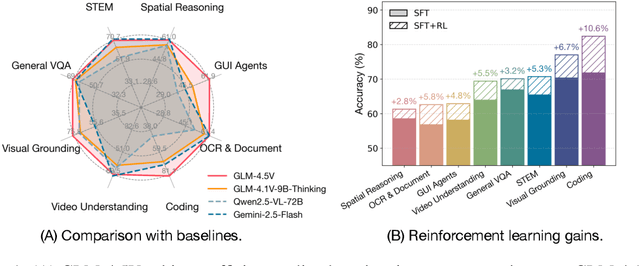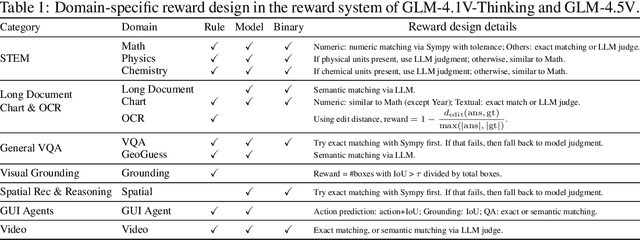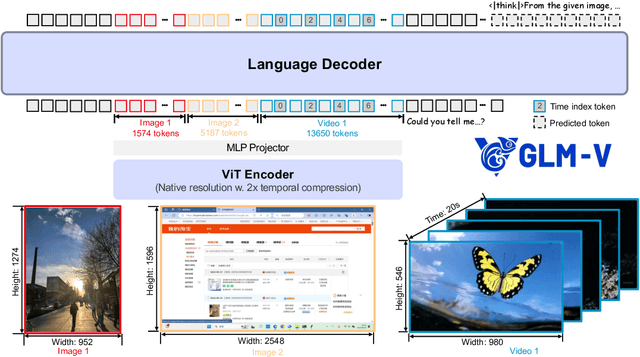Yuan Wang
Data-Efficient RLVR via Off-Policy Influence Guidance
Oct 30, 2025Abstract:Data selection is a critical aspect of Reinforcement Learning with Verifiable Rewards (RLVR) for enhancing the reasoning capabilities of large language models (LLMs). Current data selection methods are largely heuristic-based, lacking theoretical guarantees and generalizability. This work proposes a theoretically-grounded approach using influence functions to estimate the contribution of each data point to the learning objective. To overcome the prohibitive computational cost of policy rollouts required for online influence estimation, we introduce an off-policy influence estimation method that efficiently approximates data influence using pre-collected offline trajectories. Furthermore, to manage the high-dimensional gradients of LLMs, we employ sparse random projection to reduce dimensionality and improve storage and computation efficiency. Leveraging these techniques, we develop \textbf{C}urriculum \textbf{R}L with \textbf{O}ff-\textbf{P}olicy \text{I}nfluence guidance (\textbf{CROPI}), a multi-stage RL framework that iteratively selects the most influential data for the current policy. Experiments on models up to 7B parameters demonstrate that CROPI significantly accelerates training. On a 1.5B model, it achieves a 2.66x step-level acceleration while using only 10\% of the data per stage compared to full-dataset training. Our results highlight the substantial potential of influence-based data selection for efficient RLVR.
Modest-Align: Data-Efficient Alignment for Vision-Language Models
Oct 24, 2025Abstract:Cross-modal alignment aims to map heterogeneous modalities into a shared latent space, as exemplified by models like CLIP, which benefit from large-scale image-text pretraining for strong recognition capabilities. However, when operating in resource-constrained settings with limited or low-quality data, these models often suffer from overconfidence and degraded performance due to the prevalence of ambiguous or weakly correlated image-text pairs. Current contrastive learning approaches, which rely on single positive pairs, further exacerbate this issue by reinforcing overconfidence on uncertain samples. To address these challenges, we propose Modest-Align, a lightweight alignment framework designed for robustness and efficiency. Our approach leverages two complementary strategies -- Random Perturbation, which introduces controlled noise to simulate uncertainty, and Embedding Smoothing, which calibrates similarity distributions in the embedding space. These mechanisms collectively reduce overconfidence and improve performance on noisy or weakly aligned samples. Extensive experiments across multiple benchmark datasets demonstrate that Modest-Align outperforms state-of-the-art methods in retrieval tasks, achieving competitive results with over 100x less training data and 600x less GPU time than CLIP. Our method offers a practical and scalable solution for cross-modal alignment in real-world, low-resource scenarios.
A Case for Declarative LLM-friendly Interfaces for Improved Efficiency of Computer-Use Agents
Oct 06, 2025Abstract:Computer-use agents (CUAs) powered by large language models (LLMs) have emerged as a promising approach to automating computer tasks, yet they struggle with graphical user interfaces (GUIs). GUIs, designed for humans, force LLMs to decompose high-level goals into lengthy, error-prone sequences of fine-grained actions, resulting in low success rates and an excessive number of LLM calls. We propose Goal-Oriented Interface (GOI), a novel abstraction that transforms existing GUIs into three declarative primitives: access, state, and observation, which are better suited for LLMs. Our key idea is policy-mechanism separation: LLMs focus on high-level semantic planning (policy) while GOI handles low-level navigation and interaction (mechanism). GOI does not require modifying the application source code or relying on application programming interfaces (APIs). We evaluate GOI with Microsoft Office Suite (Word, PowerPoint, Excel) on Windows. Compared to a leading GUI-based agent baseline, GOI improves task success rates by 67% and reduces interaction steps by 43.5%. Notably, GOI completes over 61% of successful tasks with a single LLM call.
TopoSizing: An LLM-aided Framework of Topology-based Understanding and Sizing for AMS Circuits
Sep 17, 2025Abstract:Analog and mixed-signal circuit design remains challenging due to the shortage of high-quality data and the difficulty of embedding domain knowledge into automated flows. Traditional black-box optimization achieves sampling efficiency but lacks circuit understanding, which often causes evaluations to be wasted in low-value regions of the design space. In contrast, learning-based methods embed structural knowledge but are case-specific and costly to retrain. Recent attempts with large language models show potential, yet they often rely on manual intervention, limiting generality and transparency. We propose TopoSizing, an end-to-end framework that performs robust circuit understanding directly from raw netlists and translates this knowledge into optimization gains. Our approach first applies graph algorithms to organize circuits into a hierarchical device-module-stage representation. LLM agents then execute an iterative hypothesis-verification-refinement loop with built-in consistency checks, producing explicit annotations. Verified insights are integrated into Bayesian optimization through LLM-guided initial sampling and stagnation-triggered trust-region updates, improving efficiency while preserving feasibility.
Easier Painting Than Thinking: Can Text-to-Image Models Set the Stage, but Not Direct the Play?
Sep 03, 2025Abstract:Text-to-image (T2I) generation aims to synthesize images from textual prompts, which jointly specify what must be shown and imply what can be inferred, thereby corresponding to two core capabilities: composition and reasoning. However, with the emerging advances of T2I models in reasoning beyond composition, existing benchmarks reveal clear limitations in providing comprehensive evaluations across and within these capabilities. Meanwhile, these advances also enable models to handle more complex prompts, whereas current benchmarks remain limited to low scene density and simplified one-to-one reasoning. To address these limitations, we propose T2I-CoReBench, a comprehensive and complex benchmark that evaluates both composition and reasoning capabilities of T2I models. To ensure comprehensiveness, we structure composition around scene graph elements (instance, attribute, and relation) and reasoning around the philosophical framework of inference (deductive, inductive, and abductive), formulating a 12-dimensional evaluation taxonomy. To increase complexity, driven by the inherent complexities of real-world scenarios, we curate each prompt with high compositional density for composition and multi-step inference for reasoning. We also pair each prompt with a checklist that specifies individual yes/no questions to assess each intended element independently to facilitate fine-grained and reliable evaluation. In statistics, our benchmark comprises 1,080 challenging prompts and around 13,500 checklist questions. Experiments across 27 current T2I models reveal that their composition capability still remains limited in complex high-density scenarios, while the reasoning capability lags even further behind as a critical bottleneck, with all models struggling to infer implicit elements from prompts. Our project page: https://t2i-corebench.github.io/.
MedReseacher-R1: Expert-Level Medical Deep Researcher via A Knowledge-Informed Trajectory Synthesis Framework
Aug 20, 2025Abstract:Recent developments in Large Language Model (LLM)-based agents have shown impressive capabilities spanning multiple domains, exemplified by deep research systems that demonstrate superior performance on complex information-seeking and synthesis tasks. While general-purpose deep research agents have shown impressive capabilities, they struggle significantly with medical domain challenges, as evidenced by leading proprietary systems achieving limited accuracy on complex medical benchmarks. The key limitations are: (1) the model lacks sufficient dense medical knowledge for clinical reasoning, and (2) the framework is constrained by the absence of specialized retrieval tools tailored for medical contexts.We present a medical deep research agent that addresses these challenges through two core innovations. First, we develop a novel data synthesis framework using medical knowledge graphs, extracting the longest chains from subgraphs around rare medical entities to generate complex multi-hop question-answer pairs. Second, we integrate a custom-built private medical retrieval engine alongside general-purpose tools, enabling accurate medical information synthesis. Our approach generates 2100+ diverse trajectories across 12 medical specialties, each averaging 4.2 tool interactions.Through a two-stage training paradigm combining supervised fine-tuning and online reinforcement learning with composite rewards, our MedResearcher-R1-32B model demonstrates exceptional performance, establishing new state-of-the-art results on medical benchmarks while maintaining competitive performance on general deep research tasks. Our work demonstrates that strategic domain-specific innovations in architecture, tool design, and training data construction can enable smaller open-source models to outperform much larger proprietary systems in specialized domains.
Improving Learning of New Diseases through Knowledge-Enhanced Initialization for Federated Adapter Tuning
Aug 14, 2025



Abstract:In healthcare, federated learning (FL) is a widely adopted framework that enables privacy-preserving collaboration among medical institutions. With large foundation models (FMs) demonstrating impressive capabilities, using FMs in FL through cost-efficient adapter tuning has become a popular approach. Given the rapidly evolving healthcare environment, it is crucial for individual clients to quickly adapt to new tasks or diseases by tuning adapters while drawing upon past experiences. In this work, we introduce Federated Knowledge-Enhanced Initialization (FedKEI), a novel framework that leverages cross-client and cross-task transfer from past knowledge to generate informed initializations for learning new tasks with adapters. FedKEI begins with a global clustering process at the server to generalize knowledge across tasks, followed by the optimization of aggregation weights across clusters (inter-cluster weights) and within each cluster (intra-cluster weights) to personalize knowledge transfer for each new task. To facilitate more effective learning of the inter- and intra-cluster weights, we adopt a bi-level optimization scheme that collaboratively learns the global intra-cluster weights across clients and optimizes the local inter-cluster weights toward each client's task objective. Extensive experiments on three benchmark datasets of different modalities, including dermatology, chest X-rays, and retinal OCT, demonstrate FedKEI's advantage in adapting to new diseases compared to state-of-the-art methods.
GLM-4.1V-Thinking: Towards Versatile Multimodal Reasoning with Scalable Reinforcement Learning
Jul 02, 2025



Abstract:We present GLM-4.1V-Thinking, a vision-language model (VLM) designed to advance general-purpose multimodal understanding and reasoning. In this report, we share our key findings in the development of the reasoning-centric training framework. We first develop a capable vision foundation model with significant potential through large-scale pre-training, which arguably sets the upper bound for the final performance. We then propose Reinforcement Learning with Curriculum Sampling (RLCS) to unlock the full potential of the model, leading to comprehensive capability enhancement across a diverse range of tasks, including STEM problem solving, video understanding, content recognition, coding, grounding, GUI-based agents, and long document understanding. We open-source GLM-4.1V-9B-Thinking, which achieves state-of-the-art performance among models of comparable size. In a comprehensive evaluation across 28 public benchmarks, our model outperforms Qwen2.5-VL-7B on nearly all tasks and achieves comparable or even superior performance on 18 benchmarks relative to the significantly larger Qwen2.5-VL-72B. Notably, GLM-4.1V-9B-Thinking also demonstrates competitive or superior performance compared to closed-source models such as GPT-4o on challenging tasks including long document understanding and STEM reasoning, further underscoring its strong capabilities. Code, models and more information are released at https://github.com/THUDM/GLM-4.1V-Thinking.
CAPO: Reinforcing Consistent Reasoning in Medical Decision-Making
Jun 15, 2025



Abstract:In medical visual question answering (Med-VQA), achieving accurate responses relies on three critical steps: precise perception of medical imaging data, logical reasoning grounded in visual input and textual questions, and coherent answer derivation from the reasoning process. Recent advances in general vision-language models (VLMs) show that large-scale reinforcement learning (RL) could significantly enhance both reasoning capabilities and overall model performance. However, their application in medical domains is hindered by two fundamental challenges: 1) misalignment between perceptual understanding and reasoning stages, and 2) inconsistency between reasoning pathways and answer generation, both compounded by the scarcity of high-quality medical datasets for effective large-scale RL. In this paper, we first introduce Med-Zero-17K, a curated dataset for pure RL-based training, encompassing over 30 medical image modalities and 24 clinical tasks. Moreover, we propose a novel large-scale RL framework for Med-VLMs, Consistency-Aware Preference Optimization (CAPO), which integrates rewards to ensure fidelity between perception and reasoning, consistency in reasoning-to-answer derivation, and rule-based accuracy for final responses. Extensive experiments on both in-domain and out-of-domain scenarios demonstrate the superiority of our method over strong VLM baselines, showcasing strong generalization capability to 3D Med-VQA benchmarks and R1-like training paradigms.
Med-U1: Incentivizing Unified Medical Reasoning in LLMs via Large-scale Reinforcement Learning
Jun 14, 2025



Abstract:Medical Question-Answering (QA) encompasses a broad spectrum of tasks, including multiple choice questions (MCQ), open-ended text generation, and complex computational reasoning. Despite this variety, a unified framework for delivering high-quality medical QA has yet to emerge. Although recent progress in reasoning-augmented large language models (LLMs) has shown promise, their ability to achieve comprehensive medical understanding is still largely unexplored. In this paper, we present Med-U1, a unified framework for robust reasoning across medical QA tasks with diverse output formats, ranging from MCQs to complex generation and computation tasks. Med-U1 employs pure large-scale reinforcement learning with mixed rule-based binary reward functions, incorporating a length penalty to manage output verbosity. With multi-objective reward optimization, Med-U1 directs LLMs to produce concise and verifiable reasoning chains. Empirical results reveal that Med-U1 significantly improves performance across multiple challenging Med-QA benchmarks, surpassing even larger specialized and proprietary models. Furthermore, Med-U1 demonstrates robust generalization to out-of-distribution (OOD) tasks. Extensive analysis presents insights into training strategies, reasoning chain length control, and reward design for medical LLMs. The code will be released.
 Add to Chrome
Add to Chrome Add to Firefox
Add to Firefox Add to Edge
Add to Edge